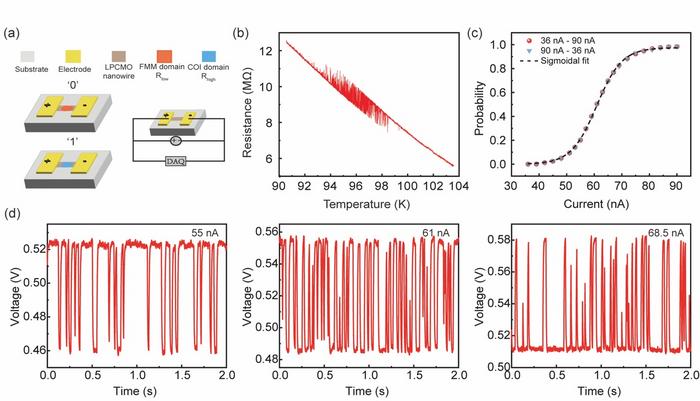Probabilistic Bits: The Future of Computing Based on Manganite Nanowires
In the realm of computer science and information technology, the architecture that has been at the forefront for nearly a century is the von Neumann model, engraved in the understanding of computation as we know it. This model, rooted in binary logic, has provided the backbone for countless innovations. However, the limitations of classical computing, especially when it comes to simulating the quantum world, have prompted researchers to investigate new approaches. The quest has led to the emergence of probabilistic computing, a field that bridges the gap between classical and quantum systems. Recently, a groundbreaking study highlighted the development of a novel probabilistic bit (p-bit) device, innovatively crafted using manganite nanowires, which has immense potential to transform computational paradigms.
Quantum mechanics inherently defies the deterministic nature of classical computers; they cannot effectively manage the uncertainty and complexity found within quantum systems. In 1981, Richard Feynman posed the significant question regarding whether computers could efficiently simulate such systems. Traditional binary computing systems falter in this realm, as they encode information in a binary format, offering limited functionality in probabilistic scenarios. The vision of quantum computers as a solution remains tantalizing yet faced with numerous technical hurdles. In parallel, researchers are exploring the concept of probabilistic computing, which endeavors to efficiently solve complex problems by embracing uncertainty.
At the heart of this paradigm shift lies the probabilistic bit, or p-bit. Unlike conventional bits that operate strictly in binary states of 0 and 1, p-bits exist in a state of flux, oscillating between these values. This dynamism enables a new approach to computing, one that taps into the inherent randomness found in physical systems, notably through thermal fluctuations. The design of p-bits must balance efficiency and stability, presenting challenges and opportunities for material scientists and engineers alike.
Recent advancements have seen a team from Fudan University, spearheaded by Professor Jian Shen and Hangwen Guo, successfully fabricate p-bit devices using manganite nanowires. This innovative material exploits the phase separation between ferromagnetic and antiferromagnetic states, allowing these devices to transition between low resistance (representing 0) and high resistance (representing 1). This transition is not merely theoretical; it has been demonstrated experimentally through precise control with nanoampere-level currents. This level of control is essential for the stability and reliability needed in practical computational applications, and it brings p-bits a step closer to widespread utilization.
What sets this research apart is not only the successful demonstration of operating p-bits but also the exceptional stability these devices exhibit. During extensive testing, the operational stability of the p-bits has been remarkable, with variations kept within a standard deviation of less than 1.3%. Stability is a critical aspect, especially in computational scenarios that require repeated operations. This finding substantiates the viability of p-bits in real-world applications, whether in optimization problems or complex simulations.
The implications of these p-bits extend far beyond mere theoretical benefits. In practical terms, simulations have showcased their critical role in tasks requiring Bayesian inference—a methodology widely applied in statistics and machine learning. The accuracy of the results derived from these p-bits was found to significantly surpass those yielded by conventional probabilistic bits. This leap in performance has profound implications, positioning this technology favorably against existing solutions while offering a viable path towards high-performance probabilistic computing.
Moreover, the device’s ability to generate high-quality intrinsic true random numbers opens new horizons in cryptographic applications. Randomness plays a pivotal role in secure communications, and harnessing a device capable of producing reliable random numbers is a commendable breakthrough in this field. As digital security threats continue to evolve, innovations like this provide not just solutions but a proactive stance against the risks associated with data usage.
This fusion of classical and quantum principles encapsulated within these manganite nanowires serves as a bridge, intertwining the established frameworks of classical computing with the promising potentials of quantum technologies. The findings from Fudan University offer a glimpse into a future where such hybrid systems could dominate computing. As researchers delve deeper, the continuing exploration of material properties and behaviors is likely to unveil even more pathways toward optimizing probabilistic computing.
The impact of these advancements is reflected not only in academia but also across industries that rely on complex computations and analyses daily. Whether enhancing logistics through optimization models or driving forward artificial intelligence algorithms, the applications of p-bits promise to permeate various sectors. Consequently, the research team’s contributions may herald a new era of computational technology.
Amidst this technological renaissance, it’s crucial to address the ongoing challenges in scaling these technologies for commercial use. While the prospects are promising, engineers and scientists will need to collaborate to overcome existing hurdles such as manufacturing processes, integration with classical systems, and data management. Bridging these gaps will be essential for transitioning theoretical advancements into tangible solutions that can benefit society at large.
In conclusion, the advent of probabilistic computing through the successful implementation of p-bits establishes a pivotal milestone in the evolution of computer science. The findings not only underscore the potential of manganite nanowires in this domain but also provide a roadmap toward realizing robust probabilistic computing systems. As research progresses, it is anticipated that such developments will ignite further innovations, ultimately enhancing our computational capabilities and understanding of the universe.
The journey of computing continues. With each breakthrough, we approach a deeper understanding of the mysteries that intertwine the classical and quantum realms and potentially revolutionize the way we interact with information technology.
Subject of Research: Probabilistic computing using manganite nanowires
Article Title: Superior probabilistic computing using operationally stable probabilistic-bit constructed by manganite nanowire
News Publication Date: 2025
Web References: http://dx.doi.org/10.1093/nsr/nwae338
References: National Science Review
Image Credits: ©Science China Press
Keywords: probabilistic computing, quantum mechanics, p-bits, manganite nanowires, Bayesian inference, cryptography, information technology, stability, optimization, true random numbers, classical computing, quantum computing




